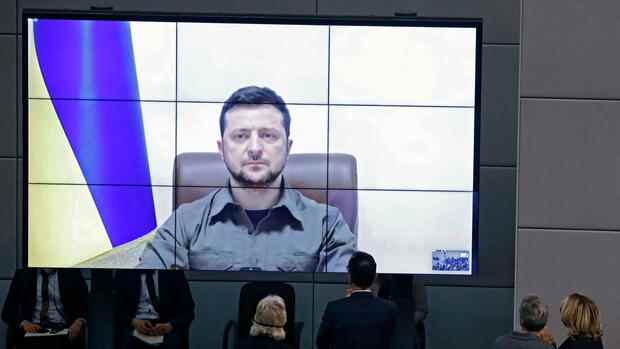Brussels The Ukrainian defenders are fighting their way forward, village by village, town by town. According to its own statements, within a few days Ukraine has recaptured 6,000 square kilometers of land – an area more than twice the size of Saarland.
Nevertheless, the danger that Russia poses to the Ukrainian state has not been averted. There are still no signs that Putin is ready for negotiations with the Ukrainian leadership. And even if one day the guns fall silent, Ukraine is unlikely to rely on Russian promises. All trust in Moscow has been destroyed, and Kyiv relies on military deterrence.
This shows the security concept for Ukraine that former NATO Secretary General Anders Fogh Rasmussen created on behalf of Ukrainian President Volodymyr Zelenskiy and presented on Tuesday. The report was co-authored by Zelensky’s chief of staff, Andriy Yermak, underscoring the paper’s political importance.
Top jobs of the day
Find the best jobs now and
be notified by email.
Rasmussen and Jermak argue that even binding legal or political measures are not sufficient to prevent renewed Russian aggression. Ukraine must be massively upgraded – and effectively become the anti-Putin bulwark on Europe’s eastern flank.
>> Watch the video here: Ukraine continues to push counter-offensive
In the short term, Ukraine can only rely on the right to self-defense under Article 51 of the United Nations Charter. For this, however, Kyiv needs “the resources that are necessary to maintain significant defense forces”.
“This will require a decades-long effort with sustained investment in Ukraine’s defense industry, scalable arms transfers, and intelligence support from allies,” Rasmussen and Ermak warn. In addition, “intensive training missions and joint exercises under the flag of the European Union and NATO” are necessary to strengthen the Ukrainian military.
All of this should be guaranteed by Ukraine’s western allies in a new security treaty, the “Kyiv Security Compact”. The USA, the United Kingdom, Poland, Italy, Germany, France, Australia and Turkey are named as contracting parties, and the Nordic, Baltic, Central and Eastern European countries are also to join the arrangement.
This is how the Handelsblatt reports on the Ukraine war and the consequences:
According to the authors, the planned EU accession could one day make a contribution to Ukraine’s security, referring to the mutual assistance clause of the European Union. The paper also does not rule out Ukraine’s NATO membership. In both cases, however, these are perspectives that offer Ukraine little protection in the short term.
Plan fuels battle tank supply debate
The German government has long been concerned with the question of how the security guarantees for Ukraine could look after the end of the war. Under the German presidency, the G7 states agreed on a declaration at the end of June in which they emphasized their willingness “to reach agreements on sustainable security commitments together with interested countries and institutions and Ukraine in order to help Ukraine to defend itself to secure their free and democratic future and to ward off future Russian aggression”. The new security treaty with Kyiv could build on this commitment.
Rasmussen’s and Yermak’s proposals should also give a boost to the German debate about the delivery of heavy weapons to Ukraine. In the past few days, calls for an export license for Leopard one or two battle tanks and Marder infantry fighting vehicles have become louder again. Chancellor Olaf Scholz (SPD) has been criticized for his hesitant attitude by both the opposition and his Green and Liberal coalition partners, but has so far stuck to the line of only supplying arms that the USA is also providing.
The former NATO chief proposes long-term investments in Ukraine’s defense capabilities.
(Photo: imago images/ZUMA Wire)
Last week, the defense ministers from around 50 supporter states met again at the US air force base in Ramstein to discuss how to proceed. Scholz took the opportunity to emphasize that he wanted an international division of labor in support, for example Germany could help with artillery and air defense systems.
>> Also read here: Putin will mobilize everything – this is how he braces himself against his downfall
Nevertheless, with Ukraine’s military successes, the pressure on Germany to deliver the martens or leopards offered by the armaments industry is also growing. “I address all those who still haven’t understood that in a war situation like this, Ukraine’s achievements can only be underpinned if they now have the weapons they need, and that includes a main battle tank,” said the chair of the defense committee, Marie-Agnes Strack-Zimmermann, recently.
Defense Minister Lambrecht: No going it alone with western armored personnel carriers and battle tanks
Defense Minister Lambrecht, on the other hand, emphasized again on Monday that so far no country has been supplying infantry fighting vehicles or battle tanks from Western production and that there will be no going it alone on this issue. Nor did she have the impression at the Ramstein meeting that her US counterpart Lloyd Austin had changed his stance on this issue.
Scholz and Lambrecht also receive public backing from the US government. Asked if Germany was doing enough to help Ukraine, Amy Gutmann, the United States Ambassador to Germany, said at the Employers’ Day in Berlin on Monday: Germany is doing everything it can. And if the United States leads the way, more is possible, she said, referring to the debate about the delivery of Western-made main battle tanks and armored personnel carriers.
Russian President Vladimir Putin tried to split the West, but failed. Gutman said, “We are more united than ever.”
More: “NATO enlargement is a serious strategic defeat for Russia,” said former NATO Secretary General Rasmussen in an interview
